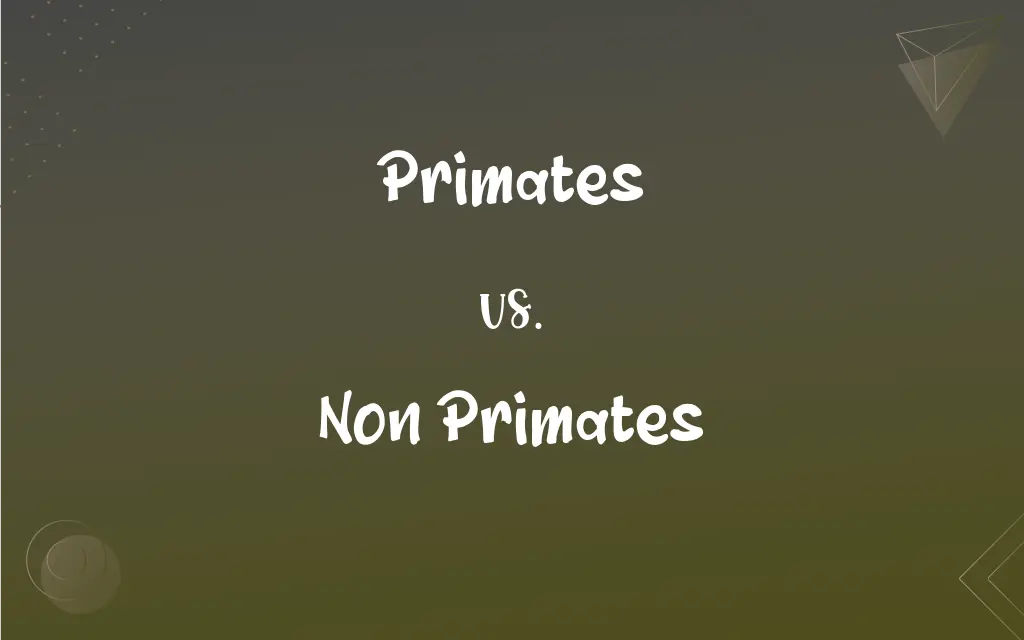Primates vs. Non Primates: What's the Difference?
Edited by Janet White || By Harlon Moss || Updated on October 25, 2023
Primates are mammals like monkeys and humans with advanced brains, while non-primates encompass all other mammals.

Key Differences
Primates are a diverse group of mammals that includes species such as humans, monkeys, gorillas, and lemurs. They are characterized by their highly developed brains, forward-facing eyes, and typically, the presence of opposable thumbs. This set of characteristics allows primates a range of motor skills, complex behaviors, and depth perception. Non-primates, in contrast, are all the other mammals that do not share these specific characteristics.
Within the animal kingdom, primates are recognized for their remarkable cognitive abilities. The primate brain, particularly in higher primates, is known for its complexity, supporting advanced learning, problem-solving, and social interactions. Non-primates, while possessing varied and often sophisticated behaviors of their own, generally lack the advanced cerebral development seen in primates.
Another noteworthy distinction between primates and non-primates lies in their locomotion and skeletal structures. Many primates are adapted for life in trees, exhibiting brachiation or leaping behaviors. Their hands and feet are often designed for grasping, and in many cases, primates display opposable thumbs or big toes. Non-primates showcase a vast array of locomotive adaptations from flying in bats to swimming in dolphins, but most lack the specific grasping adaptations found in primates.
Reproduction and lifecycle variations can also be observed between primates and non-primates. Primates generally have longer gestation periods, extended juvenile phases, and longer overall lifespans than many non-primates. The prolonged care of offspring seen in primates leads to intricate social structures and behaviors. Non-primates exhibit a broader range of reproductive strategies, lifespans, and social structures.
When examining diversity, while primates are varied and inhabit numerous ecosystems, their overall species diversity is limited compared to non-primates. The mammalian class, excluding primates, encompasses creatures as varied as whales, rodents, felines, and many more, making non-primates vastly diverse in form, habitat, and behavior.
ADVERTISEMENT
Comparison Chart
Brain Development
Highly developed brains
Varies, generally less developed than primates
Eyes
Forward-facing
Varies; can be side-facing or other positions
Digits
Often have opposable thumbs or toes
Typically lack opposable digits
Locomotion
Many are arboreal (tree-dwelling)
Various; from flying to swimming
Diversity
Limited species diversity
Broad species diversity across many mammals
ADVERTISEMENT
Primates and Non Primates Definitions
Primates
Mammals with advanced cerebral development.
Humans, as primates, have the capability for complex thought processes.
Non Primates
Animals not part of the monkey, ape, or human lineage.
Kangaroos, being non primates, are marsupials native to Australia.
Primates
The group including monkeys, apes, and humans.
Lemurs are among the more primitive primates.
Non Primates
Animals not sharing specific primate characteristics.
Bats, as non primates, have adapted for flight.
Primates
Animals characterized by forward-facing eyes and grasping hands.
Most primates, including chimpanzees, have opposable thumbs.
Non Primates
Creatures that typically lack advanced primate brains.
Despite their intelligence, dolphins are non primates.
Primates
Mammals known for intricate social structures.
Gorillas, as primates, exhibit strong family bonds.
Non Primates
Mammals excluding the primate order.
Lions, being non primates, belong to the feline family.
Primates
Creatures with prolonged offspring care periods.
Orangutans, being primates, tend to their young for many years.
Non Primates
The broad range of mammals outside the primate classification.
Elephants, as non primates, display unique trunk adaptations.
Primates
(prīmāt′) Any of various mammals of the order Primates, which consists of the lemurs, lorises, tarsiers, New World monkeys, Old World monkeys, and apes including humans, and is characterized by nails on the hands and feet, a short snout, and a large brain.
Primates
A bishop of highest rank in a province or country.
Primates
Plural of primate
Primates
The highest order of mammals. It includes man, together with the apes and monkeys. Cf. Pitheci.
Primates
An animal order including lemurs and tarsiers and monkeys and apes and human beings
FAQs
What are non primates?
Non primates refer to all mammals that do not belong to the primate order.
What are primates?
Primates are mammals that include humans, monkeys, apes, and lemurs, characterized by advanced brains and forward-facing eyes.
Why are primates' brains considered advanced?
Primates' brains support advanced learning, problem-solving, and complex social interactions.
Are primates found all over the world?
While primates are widespread, they predominantly inhabit tropical and subtropical regions.
Do non primates have forward-facing eyes like primates?
Not necessarily. While some non primates may have forward-facing eyes, it's not a defining characteristic as in primates.
Are primates endangered?
Many primate species are endangered due to habitat loss, hunting, and other factors.
Do non primates have a rich emotional life?
While it varies by species, many non primates, like elephants and canines, are believed to have a rich emotional life.
Are primates the only animals to use sign language?
While primates like chimpanzees have been taught sign language, there are instances where non primates, such as parrots, have mimicked human speech and gestures.
Can non primates exhibit complex behaviors?
Yes, many non primates also display complex behaviors, but they might differ from primate behaviors.
Which primates are closest to humans in lineage?
Chimpanzees and bonobos are the closest primates to humans in terms of lineage.
Are all non primates herbivores?
No, non primates have varied diets; some are herbivores, others carnivores, and many omnivores.
Do all primates have tails?
No, while many primates like monkeys have tails, apes and humans, which are also primates, do not.
Are cats and dogs primates or non primates?
Both cats and dogs are non primates.
Which has a broader species diversity, primates or non primates?
Non primates have a broader species diversity compared to primates.
How do primates communicate?
Primates use a combination of vocalizations, gestures, and facial expressions to communicate.
Can non primates use tools?
Yes, certain non primates, like crows and dolphins, have been observed using tools.
What's the significance of opposable thumbs in primates?
Opposable thumbs in primates aid in grasping and manipulating objects.
Do primates have a longer lifespan than non primates?
Not necessarily. While some primates, like humans, have long lifespans, many non primates also live long lives, such as certain whales.
Which primates are nocturnal?
Some lemurs and tarsiers are nocturnal primates.
Do non primates have social structures?
Yes, many non primates, like wolves or elephants, have their own intricate social structures.
About Author
Written by
Harlon MossHarlon is a seasoned quality moderator and accomplished content writer for Difference Wiki. An alumnus of the prestigious University of California, he earned his degree in Computer Science. Leveraging his academic background, Harlon brings a meticulous and informed perspective to his work, ensuring content accuracy and excellence.
Edited by
Janet WhiteJanet White has been an esteemed writer and blogger for Difference Wiki. Holding a Master's degree in Science and Medical Journalism from the prestigious Boston University, she has consistently demonstrated her expertise and passion for her field. When she's not immersed in her work, Janet relishes her time exercising, delving into a good book, and cherishing moments with friends and family.































































